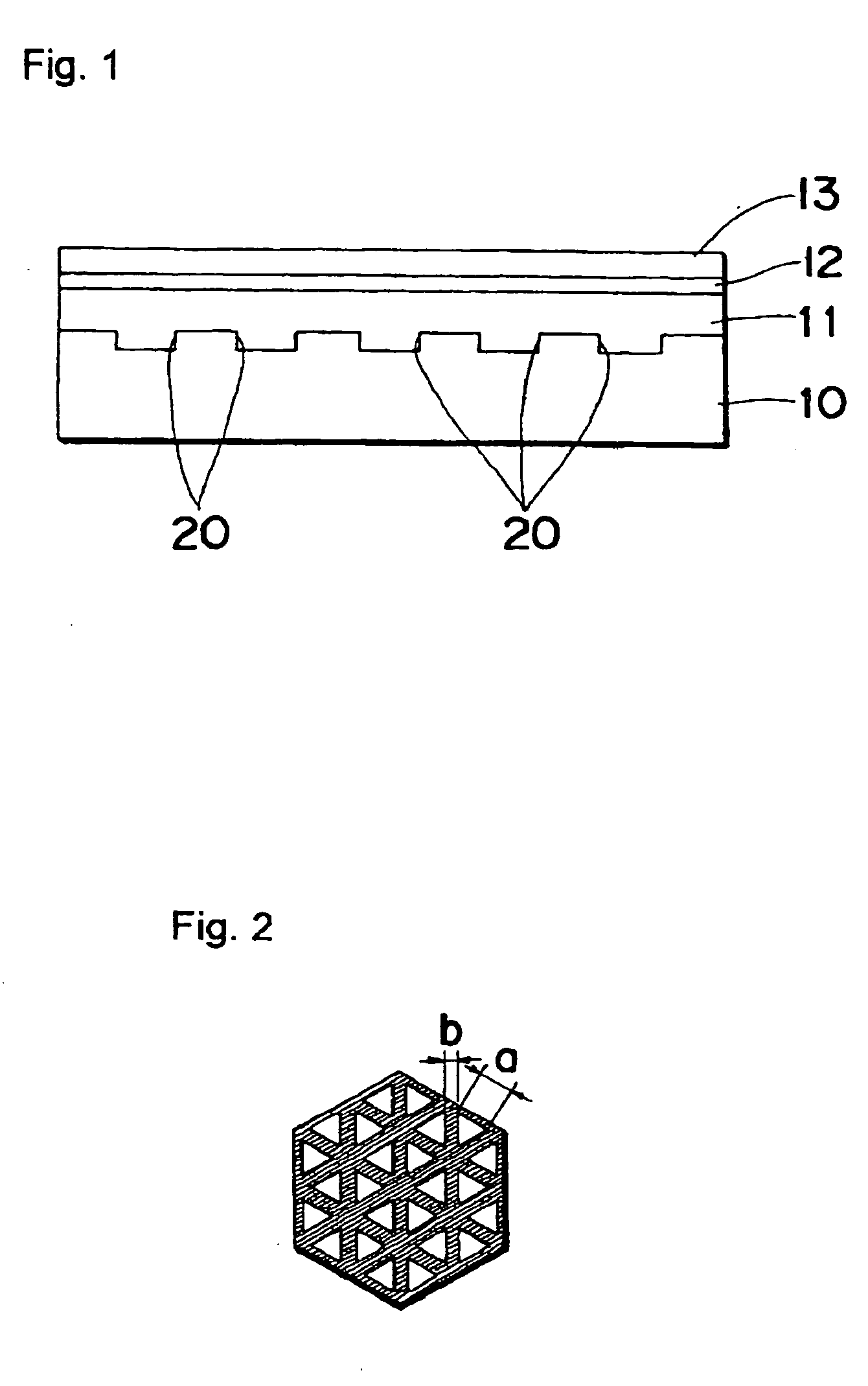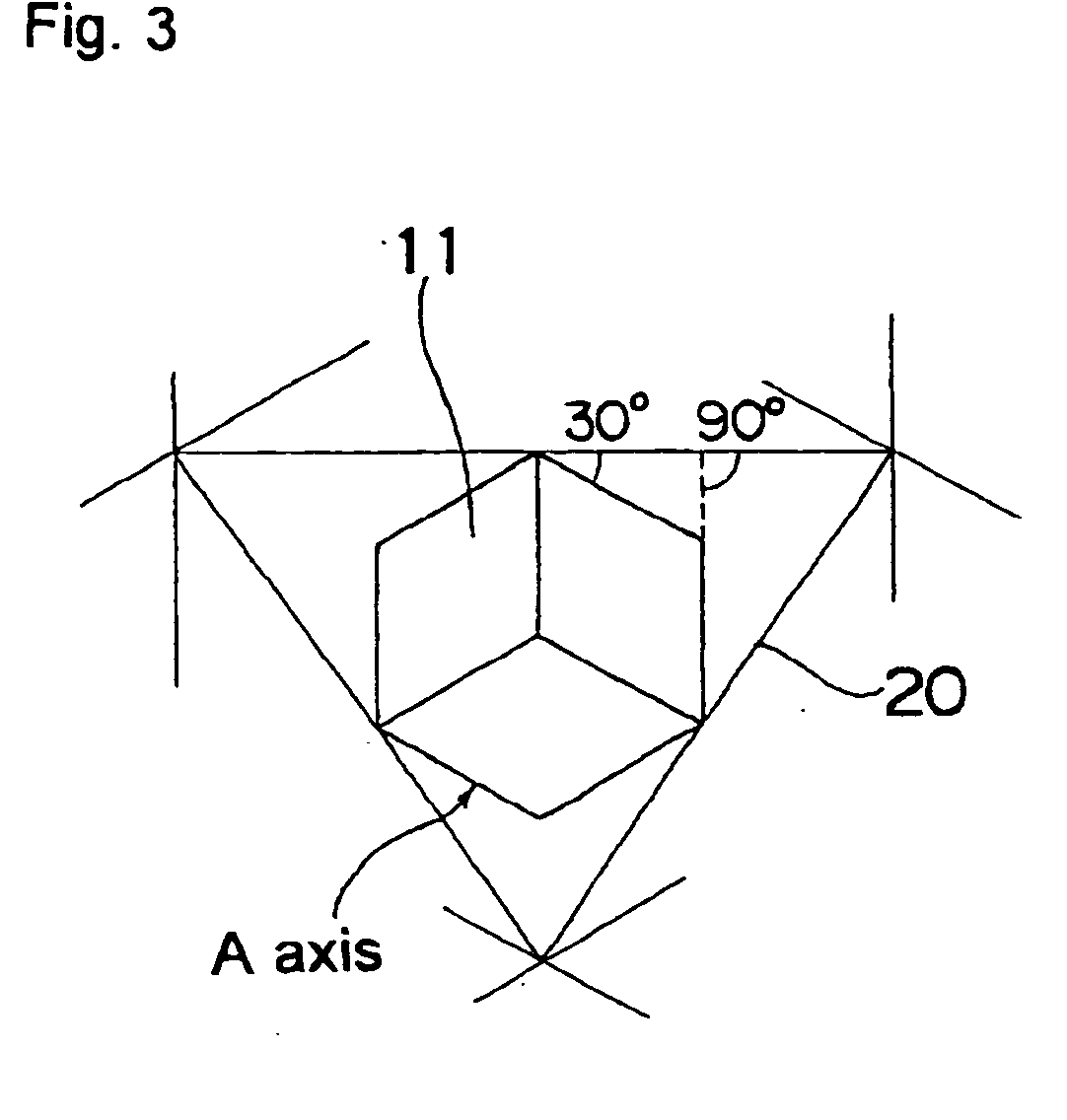Semiconductor light-emitting device
a technology of semiconductors and light-emitting devices, which is applied in the direction of solid-state devices, basic electric elements, transportation and packaging, etc., can solve the problems of insufficient external quantum efficiency, achieve the effect of improving the utilization efficiency of light, improving the output power of devices, and improving the efficiency of light utilization
- Summary
- Abstract
- Description
- Claims
- Application Information
AI Technical Summary
Benefits of technology
Problems solved by technology
Method used
Image
Examples
example 1
[0100] A sapphire substrate, of which a C plane (0001) is used as the main surface, having the orientation flat in an A plane (11-20), is used as the substrate.
[0101] First, an SiO2 film 30 that becomes an etching mask is formed on a sapphire substrate 10, as shown in FIG. 4A.
[0102] Next, a photomask of an equilateral triangle having a side of 5 μm is utilized and the photomask is arranged so that one side of the equilateral triangle becomes perpendicular to the orientation flat while the respective sides of the equilateral triangle become approximately parallel to (1-100), (01-10) and (-1010), that is to say, an M plane and then, after SiO2 film 30 and sapphire substrate 10 are etched by 3 μm to 4 μm using RIE, as shown in FIGS. 4B and 4C, a repeating pattern of protruding portions 20 (hatched areas are unetched areas, that is to say, protruding portions), as shown in FIG. 11B, is formed in the surface portion of sapphire substrate 10 when SiO2 film 30 is removed. As for the leng...
example 2
[0110] A sapphire substrate, of which a C plane (0001) is used as the main surface, having the orientation flat in an A plane (11-20) is used as the substrate.
[0111] A process in the substrate and layering of an n-type semiconductor layer to a p-type semiconductor layer are carried out in the same manner as in first example.
[0112] Next, a p-type semiconductor layer made of Mg doped GaN, an active layer and a portion of the n-type semiconductor layer are etched in order to form an n electrode so that the n-type semiconductor layer made of Si doped GaN is exposed.
[0113] Next, a photomask having a pattern wherein equilateral triangles having a side of 5 μm, as shown in FIG. 16, are most densely filled per unit area is utilized so that a light transmitting p electrode made of Ni / Au is formed on almost the entirety of the surface of the p-type semiconductor layer.
[0114] Furthermore, a p-side pad electrode made of Au is formed at a position opposite to the exposed surface of the n-typ...
example 3
[0117] A sapphire substrate, of which a C plane (0001) is used as the main surface, having the orientation flat in an A plane (11-20) is used as the substrate.
[0118] A process of the substrate and layering of an n-type semiconductor layer to a p-type semiconductor layer are carried out in the same manner as in first example.
[0119] Next, starting from Mg doped GaN, the p-type semiconductor layer, an active layer and a portion of the n-type semiconductor layer are etched in order to form an n electrode so that the Si doped GaN layer is exposed.
[0120] Next, a photomask of a square pattern is utilized so as to form a p electrode 104 made of Rh on almost the entirety of the surface of the p-type semiconductor layer. The shape of the openings is square, of which side is 7.7 μm. The interval of the openings is 6.3 μm. The aperture ratio of the opening is about 30%.
[0121] Furthermore, a p-side pad electrode made of Pt / Au is formed at a position opposite to the exposed surface of the n-t...
PUM
 Login to View More
Login to View More Abstract
Description
Claims
Application Information
 Login to View More
Login to View More - R&D
- Intellectual Property
- Life Sciences
- Materials
- Tech Scout
- Unparalleled Data Quality
- Higher Quality Content
- 60% Fewer Hallucinations
Browse by: Latest US Patents, China's latest patents, Technical Efficacy Thesaurus, Application Domain, Technology Topic, Popular Technical Reports.
© 2025 PatSnap. All rights reserved.Legal|Privacy policy|Modern Slavery Act Transparency Statement|Sitemap|About US| Contact US: help@patsnap.com



